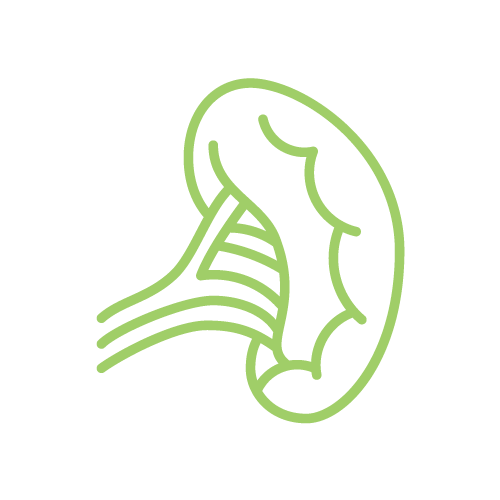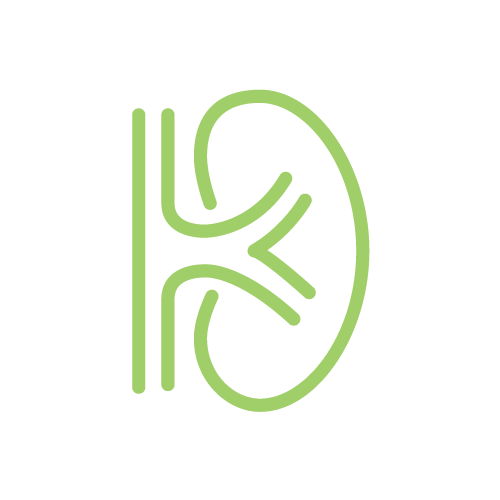
Solid Organ Surgery
The abdominal cavity of the human body contains both hollow and solid organs, all of which have important roles in digestion and other functions. Solid organs include the liver, spleen, adrenal glands and pancreas.
There are many different kinds of surgeries that can be performed on the solid organs, including resection (removal). With few exceptions, most surgeries may be performed laparoscopically or robotically, which is generally better tolerated than open surgery.
Solid Organs of the Body
Types of Solid Organ Surgery
Use the squares below to navigate the content
Splenectomy
A splenectomy is a surgical spleen removal. Removing part of the spleen is called a partial splenectomy, and removing all of it is a total splenectomy.
Indications
Splenectomy is performed to treat diseases, symptoms and conditions that affect the spleen, such as:
- Ruptured spleen, which is the most common reason for splenectomy; usually occurs as a result of a severe abdominal injury or an enlarged spleen (splenomegaly)
- Infection with abscess in the spleen resistant to other treatment
- Blood disorders, such as idiopathic thrombocytopenic purpura, polycythemia vera, sickle cell disease and thalassemia that are resistant to other treatment
- Cancer, such as chronic lymphocytic leukemia, Hodgkin’s lymphoma, non-Hodgkin’s lymphoma and hairy cell leukemia
- Noncancerous cyst or tumor inside the spleen that cannot be removed
- Enlarged spleen that causes pain and feeling of fullness
- Hereditary spherocystosis (HS)
- Splenic artery aneurysm
Procedure
Most splenectomies can be performed as minimally invasive surgeries. A tube is inserted into the abdomen through a small incision. The abdominal cavity is inflated with carbon dioxide, allowing the surgeon to see well. Other tubes are placed into the abdomen through other small incisions for the placement of surgical instruments. The spleen is cut away from its connections in the abdomen, placed in a bag and pulled out through one of the incisions in the abdomen.
In some cases, the spleen is too large for laparoscopic removal and must be removed in an open conventional surgical procedure. An open procedure may also be indicated if there is a lot of scar tissue or difficulty seeing clearly enough to perform laparoscopy. Bleeding problems are another disqualifier for laparoscopy.
While the decision of which type of surgery to perform is usually made prior to surgery, the surgeon may have to switch to an open surgery during surgery if one of these complications presents.
Recovery
After surgery, a hospital stay is required for monitoring. Pain medications and fluids are given through an IV. For an open splenectomy, a couple days to a week stay is average; laparoscopic splenectomy patients are usually sent home sooner. Four to six weeks is the average recovery period.
As with any surgery, there are possible complications. One of the most common spleen removal side effects is infection. With a splenectomy, there is also a risk of pneumonia or pancreatitis (inflammation of the pancreas). Antibiotics to prevent infection are usually given immediately before the surgery.
Because the spleen plays an important role in the body’s immune response, living without the spleen makes patients more susceptible to infections, especially dangerous bacterial infections that cause severe pneumonia, meningitis, and other serious infections. Vaccinations are usually given to patients about two weeks before surgery or approximately two weeks after emergency surgery. Other immunizations may also be recommended.
Adrenalectomy
An adrenalectomy is a surgery that removes one or both adrenal glands through minimally invasive laparoscopic surgery, traditional open surgery or cryoablation.
Indications
Adrenalectomy is performed to treat diseases, symptoms and conditions that affect one or both adrenal glands, such as:
- Benign or cancerous adrenal tumors – most common indication; one or both adrenal glands may be removed; most adrenal tumors are benign (noncancerous)
- Excess hormone production – usually due to a tumor
- Increased gland size of greater than two inches
Procedure
Laparoscopic/robotic adrenalectomies are more common than open surgery. During a minimally invasive adrenalectomy, small incisions are made in the abdomen near the belly button to access the adrenal glands. A tiny camera is inserted through one of the incisions. The abdominal cavity is filled with with gas to inflate it, which helps the surgeon see the adrenal glands clearly.
Small surgical instruments are inserted into the incisions, the adrenal glands are excised and the blood vessels cauterized. The adrenal glands are placed in a plastic bag and removed through one of the incisions.
Some adrenal glands or the tumors on them are too large for laparoscopic removal and an open surgical procedure will be performed. Large incisions are made under the ribcage or sides of the body. The glands are removed, blood vessels tied off to prevent excess bleeding, and the abdominal cavity rinsed with saline. The incisions are closed with stiches.
Cryoablation is another procedure to treat adrenal tumors using computed tomography (CT) imaging to guide the insertion of a probe used to freeze and destroy adrenal tumors. Metastatic small tumors are often treated with cryoablation by interventional radiologists when surgery carries a high risk.
Recovery
With a laparoscopic adrenalectomy, a hospital stay of one to three days is average. Open surgeries require four to five days in the hospital. There may be some pain at the incision sites as well as cramping or bloating from the gas used to inflate the abdomen.
Heavy lifting should be avoided for four to six weeks after surgery; however, adrenalectomy patients can return to work as soon as they feel ready. If the adrenalectomy removed both adrenal glands, supplemental drug therapy to replace the hormones that the adrenal glands normally produce will be required. If only one adrenal gland is removed, the remaining adrenal gland can take over all functions that both previously provided.
Pancreatectomy
A pancreatectomy is the surgical removal of part or all of the pancreas. A distal pancreatomy is a surgery to remove the body and the tail of the pancreas, and the spleen may also be removed. Distal refers to the lower portion.
Indications
A distal pancreatectomy is usually performed to remove benign or malignant pancreatic tumors found in the body or tail of the pancreas. Chronic pancreatitis and injuries to the pancreas are also indications for a distal pancreatectomy.
A pancreatectomy is used to treat a large number of diseases and conditions involving the pancreas, including:
- Pancreatic cancer
- Various benign and malignant tumors such as islet cell tumors, ampullary cancer, lymphoma and papillary cystic neoplasms
- Cancer of the distal (lower portion) of the bile duct
- Duodenal cancer
- Inflammation
- Necrotizing pancreatitis
- Severe, chronic pancreatitis
- Severe, hyperinsulinemic hypoglycemia
- Trauma
Procedure
An incision is made to view the pancreas and spleen clearly. The abdomen is filled with gas to allow the surgeon to see the abdominal cavity better. The surgeon will then decide the size of the incision and if a minimally invasive laparoscopic procedure may be appropriate. During surgery, the surgeon must decide how much of the pancreas and spleen to remove.
Three small incisions are made: one for a camera, one for surgical instruments and one for the surgeon’s hand. The surgeon removes the cancerous part of the pancreas, and if necessary, the spleen. The surgery takes between three to four hours.
Recovery
After surgery, a catheter and/or abdominal drainage tube may still be inserted. The length of time spent in the hospital after surgery depends on the type of surgery and individual speed of recovery. Most patients stay in the hospital for three to four days after a distal pancreatectomy. Solid foods are restricted for the first day or two. Pain medications will be prescribed as necessary. Fatigue may last for six to eight weeks post-surgery, but will slowly improve.
Heavy lifting (over five pounds) should be avoided for at least eight weeks. A doctor should approve any exercise; however, doing aerobic exercise, such as walking and stair climbing, will help in gaining strength and feeling better overall. Coughing and deep breathing exercises may be prescribed.
If you have a condition of one of the solid organs, request an appointment at Advanced Laparoscopic Associates. We can diagnose your condition and recommend the most effective and tolerable treatment for your situation.
Call (201) 646-1121 today and schedule your consultation with one of our surgeons!
Or use our online Request an Appointment form.




